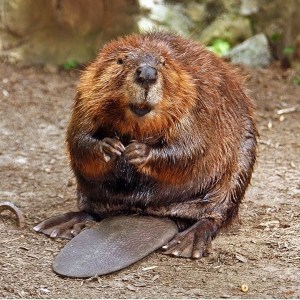
Ensayos #2 project Dear Enemy is featured in this article by Andi for Atlas Obscura
In 1946, a group of Canadian beavers got a free one-way ticket to Argentina. Specifically, they were headed for the archipelago Tierra del Fuego, a swath of islands on the southernmost tip of South America. The Argentine government thought the beavers would be the lynchpin of a new fur industry—but they were wrong.
Now, nearly 70 years later, one artist is trying to communicate with these beaver transplants—and she’s doing it entirely through smell.
Split between Argentina and Chile, Tierra del Fuego boasts cool summers and wet winters, and is marked by forests, mountains, and glaciers. There are foxes, hummingbirds, and king penguins, and a variety of whales and seals swim off its shores. And, thanks to the Argentine government, after 1946 there were beavers—beavers imported directly from Canada.
At the time the beavers arrived, beaver pelts were at a premium, which is why officials hoped to create a home-grown fur industry. (The original number of beavers imported has been reported at various numbers, from 20 to 50.) The plan to establish a fur trade failed, but the beavers, sans natural enemies, flourished.Scientists have estimated that the modern beaver population has swelled to over 100,000 or more.
And, as beavers are wont to do, the critters are cutting down trees and building dams. That’s no big deal in their Canadian homeland, but it’s a problem when you’re talking about an invasive species whose chomping grounds include the protected lands inside the Karukinka Natural Park. In 2006 Argentina and Chileteamed up to explore solutions to the beaver problem—a moment of cooperation for the countries, who have a historically acrimonious relationship. Since then, they have launched eradication efforts including trapping and rewarding beaver hunters.
Perhaps this doesn’t sound like the setup for a partnership between artists, scientists, and a Los Angeles-based art center focused on smell—but it is.

Multimedia artist Christy Gast has danced, made videos, sculptures and cyanotypes. Her work is strongly place-based; she has created projects around theEverglades, a roadtrip, and the Herbet Hoover Dike among other locales. She is also part of Ensayos, a Tierra del Fuego-based consortium of artists, scientists, and other interested parties. Founded in 2010 by curator Camila Marambio, the group creates work exploring regional issues, particularly invasive species. The group’s members are spread around the globe, but travel to Tierra del Fuego for projects. It was through this partnership that Gast got the idea that she should try to talk to beavers.
While traveling in Tierra del Fuego, Gast got to know biologist Giorgia Graells and ecologist Derek Corcoron, who conduct field research on beavers. They wondered: What if you could communicate with beavers? Maybe you could tell them something useful, such as “You have no natural predators in Tierra del Feugo, so you don’t need to chop down trees and build dams for protection.” Smell seemed like a good place to start.
Beavers don’t see or hear well, so they lean more heavily on their sense of smell. But for a beaver, the most important smell organ isn’t the nose. It’s a gland in the nether regions called the castor sac.
“The way the beaver uses it is to mark a mound that it builds,” says Gast. ”It squirts the glandular secretion on it and it also pees on it and creates a muddy, musty smell that tells other beavers that this is one beaver’s territory. And it can regulate the intensity of the smell by eating certain things.”
